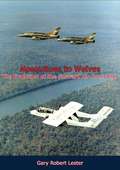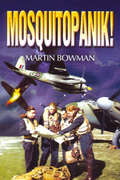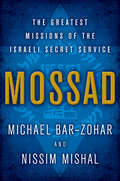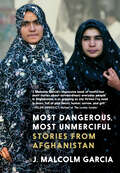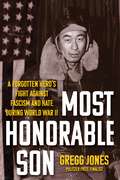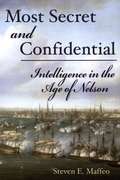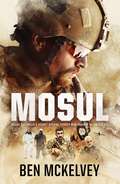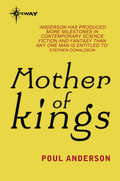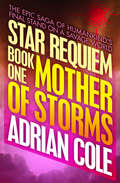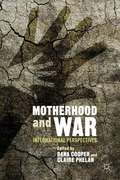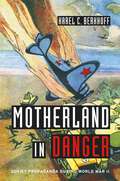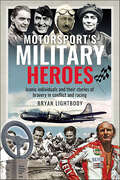- Table View
- List View
Mosquitoes to Wolves: The Evolution of the Forward Air Controller
by Gary Robert LesterComparable to twentieth century cavalry, early forward air controllers (FAC) probed, observed, and reported enemy activity. Flying rickety, underpowered, and unarmed aircraft, they operated on the leading edge of ground combat. The efficient use of airborne FACs never developed in a meaningful way in World War II, with the possible exception of their use in Marine amphibious operations in the Pacific. But the rugged terrain of Korea and the jungle mazes of Vietnam restricted the capabilities of ground controllers to identify targets, thus expanding the need for "eyes in the air." FAC roles changed from those of probing, observing, and reporting, to those of locating targets, marking them for air strikes, and taking an active role in their destruction. This expanded mission resulted in the inevitable evolution of FAC equipment and responsibilities.
Mosquitopanik! (Battlefield Britain Ser.)
by Martin W. BowmanOf all the planes that flew in WW2, the 'Wooden Wonder' the two-engined Mosquito, or Mossie as it was affectionately called, was truly the most versatile and feared by the Germans. Fast and manoeuvrable, the Mossie was just as at home in the pathfinder role as she was as a fighter interceptor, particularly of V1s, as a night-fighter, low level bomber.Mosquitopanik tells of the hugely successful war career of this much loved aeroplane that caught the public's and its pilots' imagination. Here we have gripping tales of action in the air thanks to the most meticulous research by a true enthusiast.
Mossad: The Greatest Missions of the Israeli Secret Service
by Michael Bar-Zohar Nissim MishalThe Mossad is widely recognized today as the best intelligence service in the world. It is also the most enigmatic, shrouded in secrecy. This book unveils the defining and most dangerous operations that have shaped Israel and the world at large from the agency's more than sixty-year history, among them: the capture of Adolf Eichmann, the eradication of Black September, the destruction of the Syrian nuclear facility, and the elimination of key Iranian nuclear scientists. Through intensive research and exclusive interviews with Israeli leaders and Mossad agents, authors Michael Bar-Zohar and Nissim Mishal re-create these missions in detail, bringing to life the heroic operatives who risked everything in the face of unimaginable danger.
Most Dangerous, Most Unmerciful: Stories from Afghanistan
by J. Malcolm GarciaTimely literary reporting from Afghanistan by one of our most important nonfiction writers includes insightful new writing since the US pull-out in 2021. "J. Malcolm Garcia has channeled the empathetic ear of Studs Terkel and the investigative skills of the best literary journalists ... These stories will remain in the heart and mind&’s eye forever.&” –Beth Taylor, author of The Plain Language of Love and LossReporting from Kabul and Kandahar between 2001 and 2015, J. Malcolm Garcia tells us what actually happened to the Afghan people as the conflict between first world nations and fundamentalists raged. In telling the stories of ordinary Afghans, Garcia shows the impact of years of occupation and war—and the sudden and harsh changes as new occupiers push in—on a people and their culture. Garcia meets Laila Haidary—everyone calls her &“mother&”—who, with no resources to speak of, gives addicts living on the street one month of detoxification and clean living, while at the same time sending her own children to make the perilous journey to Western Europe as best they can. And there is nine-year-old Ghani, who earns a few dollars a day collecting cans on the street to support his two brothers and sister now that his father has died of a brain tumor. There are the translators and fixers Garcia hires, who risk their lives working for foreigners against the warnings of the Taliban, and also the US soldiers who don&’t understand what their mission is here, and why they can&’t just do what they are trained to do, which is to seek out and kill the enemy. J. Malcolm Garcia has been compared to the Russian writer Svetlana Alexievich, winner of the 2015 Nobel Prize in Literature, for how the voices of everyday people ring out in the stories he tells. Most Dangerous, Most Unmerciful is an essential work of literature that documents one of the true disasters of our age, at the same time as it celebrates the human endurance and ingenuity of the Afghans we meet in these pages, and affirms the role journalists can play to make sure their stories can be heard.
Most Dangerous: Daniel Ellsberg And The Secret History Of The Vietnam War
by Steve Sheinkin<P>This captivating nonfiction investigation of the Pentagon Papers has captured widespread critical acclaim, including features in The Washington Post and on NPR, selection as a 2015 National Book Award finalist, and selection as a finalist for the 2016 YALSA Excellence in Nonfiction Award. <P>From Steve Sheinkin, the award-winning author of The Port Chicago 50 and Newbery Honor Book Bomb comes a tense, narrative nonfiction account of what the Times deemed "the greatest story of the century": how whistleblower Daniel Ellsberg transformed from obscure government analyst into "the most dangerous man in America," and risked everything to expose years of government lies during the Nixon / Cold War era. <P> On June 13, 1971, the front page of the New York Times announced the existence of a 7,000-page collection of documents containing a secret history of the Vietnam War. Known as The Pentagon Papers, these files had been commissioned by Secretary of Defense Robert McNamara. <P>Chronicling every action the government had taken in the Vietnam War, they revealed a pattern of deception spanning over twenty years and four presidencies, and forever changed the relationship between American citizens and the politicians claiming to represent their interests. <P>The investigation that resulted--as well as the attempted government coverups and vilification of the whistleblower--has timely relevance to Edward Snowden's more recent conspiracy leaks. <P>A provocative and political book that interrogates the meanings of patriotism, freedom, and integrity, Most Dangerous further establishes Steve Sheinkin as a leader in children's nonfiction.
Most Honorable Son: A Forgotten Hero's Fight Against Fascism and Hate During World War II
by Gregg JonesForeword by Naomi Ostwald Kawamura of Densho Introduction by William Fujioka of JANM Afterword by Jonathan Eig The first comprehensive biography of unjustly forgotten Japanese American war hero Ben Kuroki, who fought the Axis powers during World War II and battled racism, injustice, and prejudice on the home front. WINNER OF THE NEBRASKA BOOK AWARD Ben Kuroki was a twenty-four-year-old Japanese American farm boy whose heritage was never a problem in remote Nebraska—until Pearl Harbor. Among the millions of Americans who flocked to military stations to enlist, Ben wanted to avenge the attack, reclaim his family honor, and prove his patriotism. But as anti-Japanese sentiment soared, Ben had to fight to be allowed to fight for America. And fight he did. As a gunner on Army Air Forces bombers, Ben flew fifty-eight missions spanning three combat theaters: Europe, North Africa, and the Pacific, including the climactic B-29 firebombing campaign against Japan that culminated with the atomic bombing of Hiroshima and Nagasaki. He flew some of the war&’s boldest and bloodiest air missions and lived to tell about it. In between his tours in Europe and the Pacific, he challenged FDR&’s shameful incarceration of more than one hundred thousand people of Japanese ancestry in America, and he would be credited by some with setting in motion the debate that reversed a grave national dishonor. In the euphoric wake of America&’s victory, the decorated war hero used his national platform to carry out what he called his &“fifty-ninth mission,&” urging his fellow Americans to do more to eliminate bigotry and racism at home. Told in full for the first time, and long overdue, Ben&’s extraordinary story is a quintessentially American one of patriotism, principle, perseverance, and courage. It&’s about being in the vanguard of history, the bonding of a band of brothers united in a just cause, a timeless and unflinching account of racial bigotry, and one man&’s transcendent sense of belonging—in war, in peace, abroad, and at home.
Most Secret War (Penguin World War II Collection)
by R.V. JonesReginald Jones was nothing less than a genius. And his appointment to the Intelligence Section of Britain's Air Ministry in 1939 led to some of the most astonishing scientific and technological breakthroughs of the Second World War.In Most Secret War he details how Britain stealthily stole the war from under the Germans' noses by outsmarting their intelligence at every turn. He tells of the 'battle of the beams'; detecting and defeating flying bombs; using chaff to confuse radar; and many other ingenious ideas and devices.Jones was the man with the plan to save Britain and his story makes for riveting reading.--'This is without question the most fascinating book about WW2 that I have ever read' 5 **** Reader Review'I am glad I bought this book and I can recommend it to anybody who wants a highly readable account with plenty of detail' 5 **** Reader Review'Such a great story with so many things you wouldn't expect. A very compelling read that holds your attention' 5 **** Reader Review
Most Secret and Confidential
by Steven MaffeoIn today's world of satellites and electronic spying it is hard to appreciate the difficulties involved two centuries ago in collecting and disseminatingsecret intelligence in a time of war. This book provides a close-up look at the ingenious methods used to obtain and analyze secret material and deliver it to operational forces at sea during the age of fighting sail. It brings together information from a variety of sources to present a concise analysis of the use and development of intelligence, focusing on the British experience from 1793 to 1815, but it also covers French and American activity. In addition the book examines how commanders used the information to develop strategy and tactics and win--or sometime lose--naval battles.
Most Secret: The Hidden History of Orford Ness
by Paddy HeazellOrford Ness was so secret a place that most people have never heard of it. The role it played in inventing and testing weapons over the course of the twentieth century was far more significant and much longer than that of Bletchley Park. Nestled on a remote part of the Suffolk coast, Orford Ness operated for over eighty years as a highly classified research and testing site for the British military, the Atomic Weapons Reserach Establishment and, at one point, even the US Department of Defence. The work conducted here by some of the greatest 'boffins' of past generations played a cruicial role in winning the three great wars of the twentieth century: the First, Second and the Cold. Hosting dangerous early night flying and parachute testing during the First World War, the ingenious radar trials by Watson Watt and his team in the 1930s, through to the testing of nuclear bombs and the top-secret UK-US COBRA MIST project, the 'Ness' has been at the forefront of military technology from 1913 to the 1990s. Now a unique National Trust property and National Nature Reserve, its secrets have remained buried until recently. This book reveals an incredible history, rich with ingenuity, intrigue and typical British inventiveness.
Mosul: Australia's secret war inside the ISIS caliphate
by Ben MckelveyFrom the best-selling author of The Commando and Born to Fight comes a fascinating investigation of modern warfare that combines methodical research and the fast-paced action of battle with the personal stories of the combatants on both sides of the line.Taking us from the suburbs of western Sydney and Australia's military army bases, to the battlefields of Afghanistan and Iraq, this is a remarkable book that reveals the as-yet untold story of the battle for Mosul and the secret involvement of Australians on both sides of the war - both our Commandos and Australian ISIS fighters.Mosul details the rise of ISIS influence in Australia, the Iran and Australia allegiance to fight Daesh and shows what led up to the battle and the ramifications that are still being felt at home - by our soldiers and the victims of that war.Ben Mckelvey has extraordinary access to SOOCOMD/2COMMANDO units - the most decorated modern Australian fighting unit; ISOF - Iraq's premier fighters; Yazidis women who had been slaves of ISIS; returned Commandos and their devastated families, and explains how petty criminals in Western Sydney became some of our worst jihadists who took their families to Iraq to fight for ISIS. Focusing on the stories of key figures like 2 Commando's Ian Turner and one of Australia's most infamous Jihadist, Khaled Sharrouf, Mckelvey takes us the heart of this brutal battle and brings history to life in an honest, thoughtful and compelling examination of modern warfare.A must-read for anyone interested in modern military history.
Mosul: Australia's secret war inside the ISIS caliphate
by Ben MckelveyFrom the best-selling author of The Commando and Born to Fight comes a fascinating investigation of modern warfare that combines methodical research and the fast-paced action of battle with the personal stories of the combatants on both sides of the line.Taking us from the suburbs of western Sydney and Australia's military army bases, to the battlefields of Afghanistan and Iraq, this is a remarkable book that reveals the as-yet untold story of the battle for Mosul and the secret involvement of Australians on both sides of the war - both our Commandos and Australian ISIS fighters.Mosul details the rise of ISIS influence in Australia, the Iran and Australia allegiance to fight Daesh and shows what led up to the battle and the ramifications that are still being felt at home - by our soldiers and the victims of that war.Ben Mckelvey has extraordinary access to SOOCOMD/2COMMANDO units - the most decorated modern Australian fighting unit; ISOF - Iraq's premier fighters; Yazidis women who had been slaves of ISIS; returned Commandos and their devastated families, and explains how petty criminals in Western Sydney became some of our worst jihadists who took their families to Iraq to fight for ISIS. Focusing on the stories of key figures like 2 Commando's Ian Turner and one of Australia's most infamous Jihadist, Khaled Sharrouf, Mckelvey takes us the heart of this brutal battle and brings history to life in an honest, thoughtful and compelling examination of modern warfare.A must-read for anyone interested in modern military history.
Mother Daughter Traitor Spy: A Novel
by Susan Elia MacNealFrom the New York Times bestselling author of the Maggie Hope series comes a tantalizing standalone novel inspired by a real-life mother-daughter duo who stumble upon an underground Nazi cell in Los Angeles during the early days of World War II—and find the courage to go undercover.&“Stirring . . . Susan Elia MacNeal&’s page-turning prose is as entertaining as ever—I was riveted from beginning to end.&”—Kate Quinn, author of The Alice NetworkJune 1940. France has fallen to the Nazis, and Britain may be next—but to many Americans, the war is something happening &“over there.&” Veronica Grace has just graduated from college; she and her mother, Violet, are looking for a fresh start in sunny Los Angeles. After a blunder cost her a prestigious career opportunity in New York, Veronica is relieved to take a typing job in L.A.—only to realize that she&’s working for one of the area&’s most vicious propagandists.Overnight, Veronica is exposed to the dark underbelly of her new home, where German Nazis are recruiting Americans for their devastating campaign. After the FBI dismisses the Graces&’ concerns, Veronica and Violet decide to call on an old friend, who introduces them to L.A.&’s anti-Nazi spymaster.At once, the women go undercover to gather enough information about the California Reich to take to the authorities. But as the news of Pearl Harbor ripples through the United States, and President Roosevelt declares war, the Grace women realize that the plots they&’re investigating are far more sinister than they feared—and even a single misstep could cost them everything.Inspired by the real mother-daughter spy duo who foiled Nazi plots in Los Angeles during WWII, Mother Daughter Traitor Spy is a powerful portrait of family, duty, and deception that raises timeless questions about America—and what it means to have courage in the face of terror.
Mother London
by Michael MoorcockShortlisted for the Whitbread Award, award-winning author of the Elric series Michael Moorcock offers a captivating and immersive portrait of London from World War II through the 1980s through the eyes of three outpatients from a mental hospital.In this masterful exploration of the human condition, three outpatients from a mental hospital—a music hall artist, reclusive writer, and a woman just awoken from a long coma—experience the history of London from the Blitz to the late 1980s through a chaotic experience of sensory delusions. Believing themselves to hear voices from London&’s past, their fragmented and poignant stories create a tapestry of episodes, snippets, and sidelines that capture the essence of those living on society&’s fringes. What The Guardian calls &“a great, humane document,&” Mother London is a literary work that transcends time and place and is a must-read for literary and historical fiction fans alike.
Mother of Bourbon: The Greatest American Whiskey Story Never Told
by Eric GoodmanThe outrageously inspiring story of the most successful and influential woman distiller of Kentucky Bourbon that nobody&’s heard…until now! Introducing Mary Dowling, Mother of Bourbon.&“Unsung bourbon distiller—and force of nature—Mary Dowling overcame family tragedy, discrimination, and Prohibition, to achieve extraordinary success. Her story comes to life in this page-turning novel.&” —Susan Reigler, author of Kentucky Bourbon: The Essential Guide to the American Spirit Born in 1859 to Irish immigrants who&’d escaped the great potato famine, Mary Dowling arrived at the height of anti-Irish and anti-Catholic fervor in America. The hardscrabble life her family led provided the foundation of grit and determination that would serve her well, along with a natural gift for numbers and planning. She married the enterprising John Dowling when she was just fifteen and he was thirty-three. Despite their age gap, John was a kind and adoring husband who recognized Mary&’s remarkable skills and made her his partner not just in life but in business. He offered her oversight of their burgeoning bourbon company&’s financial books and sought her insight and advice on acquisition and expansion as they steadily grew from distillery investors to sole proprietors of Waterfill and Frazier in Tyrone, Kentucky, just outside Lawrenceburg, in the heart of Bourbon Country. &“Mother of Dragons? Give me the Mother of Bourbon! In this historical fiction, Kaveh Zamanian and Eric Goodman break the boundaries of traditional bourbon books, just like the woman it&’s based on—Mary Dowling. From love to business, this bourbon soap opera is a must read, will keep you entertained, and make you question everything you thought you knew about America&’s Spirit.&” —Fred Minnick, author of Bourbon: the Rise, Fall and Rebirth of an American Whiskey, Bourbon Curious, and Whiskey Women: The Untold Story of How Women Saved Bourbon, Scotch and Irish Whiskey Mary&’s first trials arrive at the turn of the century in a series of tragedies that leave her widowed and with a business no one wants to support. Steering not only the lives of her eight children, she bucks up against a male-dominated bank and distributor that drop her because women don&’t run businesses, to align herself with progressive partners who value the dollar over outdated ideas about gender. She scales to ever higher heights, becoming an influential member of Lawrenceburg society while achieving immense wealth at a time when women still couldn&’t vote. When Prohibition arrives with its attendant animosity toward immigrants and Catholics, Mary is forced into semi-retirement—until the federal government comes after her on trumped-up charges of bootlegging. Only then does she bite back, determining that if she is going to be treated like a criminal, she will behave like one—taking her operation to Juarez, Mexico, to begin another iteration of Waterfill and Frazier that would distill and legally distribute bourbon throughout Mexico and, less legally, north into the US. Mother of Bourbon: The Greatest American Whiskey Story Never Told is the never-before-told story of a pioneering and visionary woman who achieved success in a system designed to suppress her, and against a government that strived to repress her. Mary&’s courage and determination are the hallmarks that live on today in Mary Dowling Whiskey, as extraordinary and distinctive as the woman whose name it bears.
Mother of Kings
by Poul AndersonAs a child of just seven summers, Gunnhild finds herself fascinated with the powers of a witch-woman who is a concubine of her father's, a powerful Norse chieftain. She also finds another fascination in handsome and lordly Eirik, son of their king. When her mother dies, Gunnhild promises, "I will never yield", and that, "through me, our blood shall flow greatly".Gunnhild has learned from her chieftain father the way the powerful use the weak. But there are other lessons and other power she seeks. Sent away to learn the magic of a pair of shamans, Gunnhild becomes a Spaewife - a knower of the Gods, a master in the ways of witchcraft and sorcery. Aided by her new abilities, Gunnhild marries Eirik. She is destined to become queen, and her magic is a fearsome complement to Eirik's strength. But Eirik's enemies are cunning, and Gunnhild is soon without his might.If Gunnhild can keep the promise she made as a child to never yield, her family's blood will flow greatly, and the sons she bore Eirik will each become a king. Her own struggles, though, are far from over...
Mother of Storms (Star Requiem #1)
by Adrian ColeThe epic Star Requiem fantasy series begins on an inhospitable world where elemental gods plan the destruction of the human race. It is on this planet, where only the Windmasters can summon the devastating power of rain, gale, thunder, and lightning, that the last surviving remnants of humankind have come, fleeing the destruction of their empire at the hands of the alien Csendook. And it is here the human race will be resurrected...or exterminated. The sorcerers of this barbaric, inhospitable world have vowed to cleanse Innasmorn of the uninvited "abomination." And somewhere in the swirl of the dimensions--eons distant but as near as a word of power--the relentless Csendook destroyers scent human blood on the galactic wind. "Adrian Cole has a magic touch." -- Roger Zelazny Don't miss the entire Star Requiem quartet: Mother of Storms, Thief of Dreams, Warlord of Heaven, Labyrinth of Worlds
Motherhood and War
by Dana Cooper Claire PhelanTraditional histories of war have typically explored masculine narratives of military and political action, leaving private, domestic life relatively unstudied. This volume expands our understanding by looking at the relationships between mothers and children, and the varied roles both have assumed during periods of armed conflict.
Motherhouse
by David Fennario"When a final analysis is made of twentieth-century Canadian theater, the most significant political playwright will undoubtedly be David Fennario."--Canadian Book ReviewThis powerful drama gives a voice to the disillusioned working-class women employed at the British Munitions Factory in Verdun, Quebec, during World War I. Despite tension over conscription, dedicated mothers, wives, sisters, and sweethearts assemble artillery shells to support the war effort. Meanwhile, their beloved soldiers die abroad and their children starve at home because of war profiteers.David Fennario is an award-winning playwright and performer whose plays have been widely produced as well as televised on the Canadian Broadcasting Corporation.
Motherland in Danger
by Karel C. BerkhoffMuch of the story about the Soviet Union’s victory over Nazi Germany has yet to be told. In Motherland in Danger, Karel Berkhoff addresses one of the most neglected questions facing historians of the Second World War: how did the Soviet leadership sell the campaign against the Germans to the people on the home front? For Stalin, the obstacles were manifold. Repelling the German invasion would require a mobilization so large that it would test the limits of the Soviet state. Could the UR marshal the manpower necessary to face the threat? How could the authorities overcome inadequate infrastructure and supplies? Might Stalin’s regime fail to survive a sustained conflict with the Germans? Motherland in Danger takes us inside the Stalinist state to witness, from up close, its propaganda machine. Using sources in many languages, including memoirs and documents of the Soviet censor, Berkhoff explores how the Soviet media reflected-and distorted-every aspect of the war, from the successes and blunders on the front lines to the institution of forced labor on farm fields and factory floors. He also details the media’s handling of Nazi atrocities and the Holocaust, as well as its stinting treatment of the Allies, particularly the United States, the UK, and Poland. Berkhoff demonstrates not only that propaganda was critical to the Soviet war effort but also that it has colored perceptions of the war to the present day, both inside and outside of Russia.
Motherland, Fatherland, Whateverland: Searching for Home
by Erik SmalhoutErik Smalhout was born a child of privilege in the Netherlands East Indies. Smalhout’s father sent his unruly son to a boarding school in Australia, just months before the Japanese seized the Netherlands East Indies in early 1942. While young Smalhout adapted to life in rural Australia, his sister and father back home were placed in Japanese prison camps, an experience that proved fateful for his father and changed his sister’s life forever. Serendipity followed him through induction in the WWII Dutch military, his postwar service on merchant ships circling the globe, and eventually to the most southern place on earth: the Mississippi Delta. Smalhout spent the rest of his life adapting to challenging circumstances time after time: first as a progressive Dutchman in the American South, then as an IRS agent in the nation’s second-largest financial center, and finally as a man who, due to a diagnosis of Alzheimer’s, often could not identify himself. Motherland, Fatherland, Whateverland: Searching for Home is Smalhout’s memoir, edited by his granddaughter, Erika Berry, and supported with pictures and documents that he saved throughout his lifetime. Smalhout’s story reminds readers that place is secondary to experience and that no matter where we are or what fortunate or unfortunate circumstances placed us there, an eternal curiosity for humanity will help us find a place in the world.
Motherland: A Feminist History of Modern Russia, from Revolution to Autocracy
by Julia IoffeFINALIST FOR THE NATIONAL BOOK AWARDAcclaimed journalist Julia Ioffe tells the story of modern Russia through the history of its women, from revolution to utopia to autocracy.In 1990, seven-year-old Julia Ioffe and her family fled the Soviet Union. Nearly twenty years later, Ioffe returned to Moscow—only to discover just how much Russian society had changed while she had been living in America. The Soviet women she had known growing up—doctors, engineers, scientists—seemed to have been replaced by women desperate to marry rich and become stay-at-home moms. How had Russia gone from portraying itself as the vanguard of world feminism to becoming a bastion of conservative Christian values?In Motherland, Ioffe turns modern Russian history on its head, telling it exclusively through the stories of its women. From her own physician great-grandmothers to Lenin’s lover, a feminist revolutionary; from the hundreds of thousands of Soviet girls who fought in World War II to the millions of single mothers who rebuilt and repopulated a devastated country; from the members of Pussy Riot to Yulia Navalnaya, the wife of opposition leader Alexey Navalny, Ioffe chronicles one of the most audacious social experiments in history and documents how it failed the very women it was meant to liberate—and how that failure paved the way for the revanche of Vladimir Putin.Part memoir, part journalistic exploration, part history, Motherland paints a portrait of modern Russia through the women who shaped it. With deep emotion, Ioffe reveals what it means to live through the cataclysms of revolution, war, idealism, and heartbreak—and how the story of Russia today is inextricably tied to the sacrifices of its women.
Motivation in War: The Experience of Common Soldiers in Old-Regime Europe
by Ilya BerkovichThis book fundamentally revises our notion of why soldiers of the eighteenth century enlisted, served and fought. In contrast to traditional views of the brutal conditions supposedly prevailing in old-regime armies, Ilya Berkovich reveals that soldiers did not regard military discipline as illegitimate or unnecessarily cruel, nor did they perceive themselves as submissive military automatons. Instead he shows how these men embraced a unique corporate identity based on military professionalism, forceful masculinity and hostility toward civilians. These values fostered the notion of individual and collective soldierly honour which helped to create the bonding effect which contributed toward greater combat cohesion. Utilising research on military psychology and combat theory, and employing the letters, diaries and memoirs of around 250 private soldiers and non-commissioned officers from over a dozen different European armies, Motivation in War transforms our understanding of life of the common soldier in early modern Europe.
Motorcycles at War: Rare Photographs From Wartime Archives (Images of War)
by Gavin BirchMotorbikes were widely used by all sides in WW2 due to their agility, adaptability and speed,. A precious few survive today as rare collectors items.The author, who is the Photo Archivist at the IWM has unearthed images of all the major marques. Famous British names (Triumph, Norton, Matchless, BSA, Velocette, James and Rudge) feature along with the bigger American machines from Indian and Harley-Davidson. German bikes have their own chapter with classics such as NSU, Zundapp and BMW and include hybrid traed motorcycles known as Kettengrad with some shots actually taken by General Erwin Rommel himself.Also covered are rare experimental prototypes photographed during trials and later in combat, the funnies of the wartime biking world such as the Airborne forces Excelsior Welbike (British) and the Cushman parascooter (US).Together this is a unique collection of two-wheeled images.
Motorsport’s Military Heroes: Iconic Individuals and Their Stories of Bravery in Conflict and Racing
by Bryan LightbodyMotorsport has many iconic names attached to it. It has many that are celebrated as heroes in their chosen sport. However, what perhaps is less well known is how many of the motorsport icons of the twentieth century carried out acts of real-life bravery, many during war time, but some in selfless acts of bravery in saving the lives of their fellow competitors. Some of the iconic names of motorsport are linked to the great conflicts of the twentieth century. Enzo Ferrari served during World War One, the most revered of the 1920s Bentley Boys were all World War One veterans such as John Duff, Bernard Rubin, Woolf Barnato, Sammy Davis and Glen Kidston. World War One American flying ace Eddie Rickenbacker was an Indianapolis 500 racing driver. Muriel Thompson, Military Medal, who became a World War One ambulance driver, was not only a chauffeur for suffragette Emeline Pankhurst, but raced at Brooklands before the war. Commentator Murray Walker was a World War Two tank commander, fellow commentator Raymond Baxter was a Spitfire pilot who was mentioned in dispatches for bravery. Carroll Shelby was a United States Army Airforce pilot and instructor with a reputation for great leadership. His friend, engineer and racing driver Ken Miles, served throughout the war as a specialist in tank recovery, landing as part of the D-Day operations. These are just a few of the most notable names from a group of men and women who risked all in conflict, before risking all on the track profiled in this book.
Mount Lu Hun: Volume 1 (Volume 1 #1)
by Zhang DaiAll your three kingdoms are in the world, while the world of the flat pea is in a mountain. Your three kingdoms all go out to collect your brothers and sisters to fish for beautiful girls and boast, but the world of flat peas, is only the morning dew against the sunset, the grass against the winter, the sky above the earth, against the spring and autumn and the earth above the mountains.
